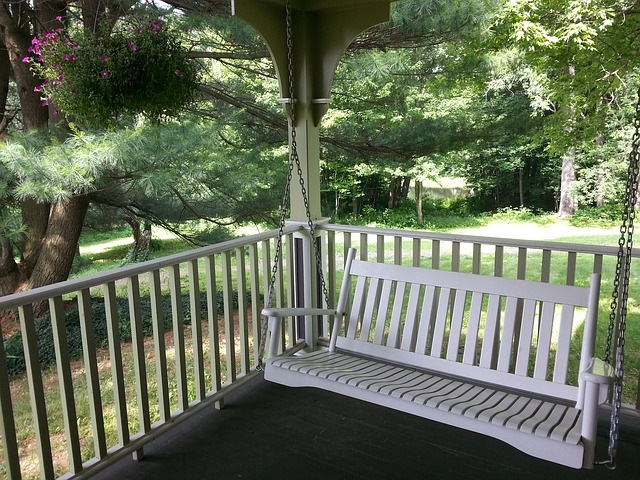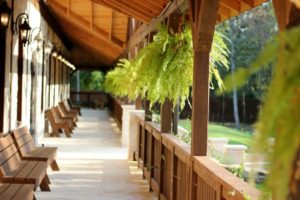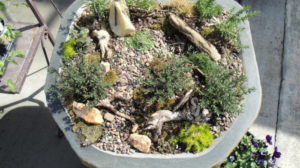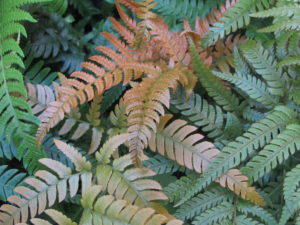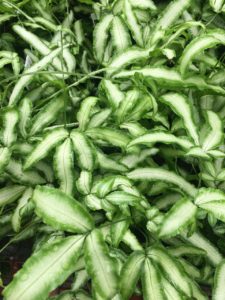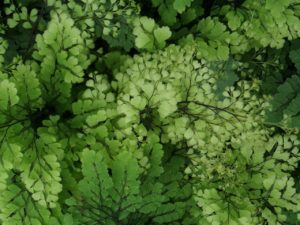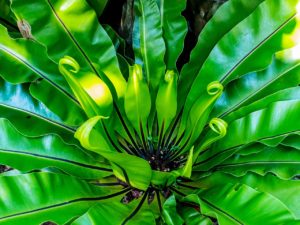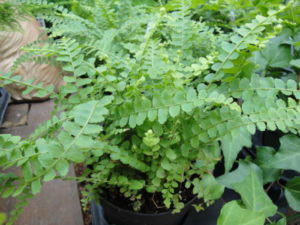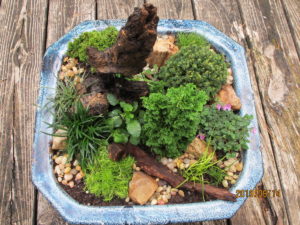2018
A Shady Porch Planter
It is hot outside! This week’s temperatures are soaring well above normal. Throw in the (dis)comfort level, and it feels like it’s over 100 degrees out there! I refreshed the bird bath a few minutes ago. Three cardinals and a Carolina wren less than 15 feet away waited for me to leave.
We haven’t had rain for…well, the grass already is brown, and the trees’ leaves are beginning to flag…
We retreat to air-conditioned spaces, emerging in the evening to collect mail, pull some weeds, or feed the birds. A welcoming porch offers shade and a tall pitcher of iced tea shared with a friend. But, for a gardener like me, something is missing from this setting. That something would be plants!
Although a shady porch planter won’t support the blaze of color we see in our flower gardens, there are lots of plants that will grow there. Here in the Carolinas, a 12″ hanging basket filled with a well-tended Boston fern is a classic. It will require daily watering and fertilizing every 2 or 3 weeks. During cooler weather, in spring and fall, it will take some direct sunlight. Sitting on Grandma’s antique fern stand or hanging between posts, the Boston fern is beautiful in its simplicity. There’s something “cool” in that lush greenery, a calm repose…
But If It Goes Too Dry…
If the soil dries, there will be hundreds of little reminders shed from the older fronds. I’m talking about the pinnae, the small leaflets that line the midrib of the fern frond. Pull up the foliage and snip, down to soil level, the older, yellowing fronds. A certain amount of this shedding is expected, due to heavy shade on the lower fronds.
Soil that runs too dry will result in accelerated loss of foliage. And the edges of tender new fronds will turn crispy brown. I’ve seen ferns that looked dead from lack of water. But with a severe trim, down to soil level, and improved watering practices, the plants can recover. In a week or so, you’ll notice new growth emerging from the crown of the plant if the root system hasn’t been entirely killed off.
Plastic hanging baskets often have a 1″ deep reservoir in the bottom of the pot. Water your fern heavily enough to fill the reservoir. The plant will soon soak up that excess, so usually there is no need to empty it. I don’t recommend this for all plants, however–just the thirsty ones.
Under a porch that gets some direct sun, look for a fern variety called ‘Kimberly Queen’. Its habit is more upright, so it looks best sitting on the porch or on a low plant stand. Where conditions are too sunny for a Boston fern, ‘Kimberly Queen’ should do well.
Following the Path of Least Resistance
One note about all potted plants: if water gushes out the holes immediately after watering, there’s empty space between the outside of the root ball and the inside of the pot. This space will need to be filled with potting soil, using a tool of some sort. Firm the soil all around, filling in the gaps, or the water will find that one air channel that remains unfilled. This will cause some or much of the root system to remain dry.
Why this happens:
- letting the soil go too dry, causing the soil mass to shrink.
- bumpy transportation, shifting loose soil around the pot, causing air pockets to form.
- heavy roots or fern rhizomes (underground stems) growing along the sides of the root ball or coiled around the bottom of the pot (Bear’s-foot fern rhizomes, or the massive root systems of asparagus fern and spider plant). Strong roots can raise the whole plant higher in the pot. Most pots taper (become narrower) toward the bottom of the pot, so a gap will open as the root ball rises up.
- loosely-packed soil. Firm the soil–not too hard and not too soft. Avoid piling new soil on top of the root ball. You might have to remove the plant in order to add soil under the root ball.
Ferns and Friends—Made for Shade

I love ferns. A combination of different species planted together in a rustic planter, an aged clay pot, or a hollowed-out birch log speaks to my appreciation of the Permian aesthetic. Add a piece of driftwood, live moss, and some rocks collected from who-knows-where, and you’ve got a simple prehistoric scene straight out of Jurassic Park. Maybe you could borrow one of the kids’ toy dinosaurs…
Another “pot” that makes a cool miniature garden is a leaky birdbath. I turned a cracked granite birdbath into a tiny campsite, complete with shelter, a forest of prostrate rosemary, a firepit, and pebble pathways between clipped thyme plants (photo, right). Irish and Scottish mosses (Sagina subulata) served as the “lawn”, with driftwood logs for seating. (This one grew in direct sun most of the day.)
Look around; there might be something in the basement, at Good Will, or at a Habitat for Humanity Restore that can be transformed into something special.
Keep the fern arrangement in the shade. Two hours of direct sunlight on a hot summer day might prove fatal to these delicate denizens of the underbrush. And even though ferns like moist conditions, planting them in pots without drainage holes can result in a smelly anaerobic bog, suffocating their roots.
Avoid placing your porch planter in a windy location; ferns prefer the humidity and stillness of calm, close quarters.
So Many Choices
There are many ferns to choose from:
- maidenhair ferns (Adiantum),
- variegated brake ferns (Pteris),
- lemon button fern and dwarf Boston ferns (Nephrolepis),
- rabbit’s-foot fern (Davallia), with its fuzzy rhizomes,
- the less fern-like bird’s nest fern (Asplenium) and Hart’s tongue fern (Phyllitis, a perennial),
- fern allies, such as Selaginella, available in several colors and forms.
Among their numerous cultivars are smaller specimens, growing up to 12″ or 14″ tall, easily accommodated indoors when autumn approaches. Indoors, give them cool morning sun or very bright indirect light. I don’t recommend “low light” for anything, not even ferns. Stronger light makes stronger tissues, which will better tolerate indoor conditions.
- Cinnamon gold color on new fronds of Dryopteris ‘Golden Mist’. This is a hardy perennial.
- Brake fern (Pteris cretica).
- The crocodile fern (Microsorium musifolium ‘Crocydyllus’).
- Maidenhair fern (Adiantum sp.).
- Bird’s nest fern (Asplenium nidus).
- Lemon button fern (Nephrolepis var.)
Small Scale Gardening In a Porch Planter
With the popularity of miniature gardens, or fairy gardens, tiny 2″ pots of young plants are popping up all over the gardening world. You can find young ferns in a wide variety of foliage colors and textures.
Garden centers also sell assortments of succulents, flowering plants, houseplants, and terrarium plants, but not all are suitable for a shady porch planter or indirect light indoors. And get some information on the growth habits of the plants. Different varieties of ferns might grow only 2″ tall or over 4 feet tall! I grew the little 2″ fern 30 years ago; it was called New Zealand something…I’ll have to see if I can find it again. So cute!
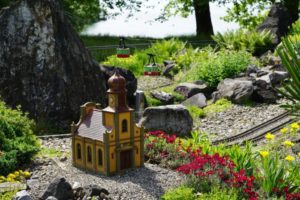
For many years, I grew tiny plants under lights, including miniature strawberry begonia (Saxifraga cuscutaeformis), miniature African violets and their 1″ tall cousin Sinningia pusilla. And there was Sonerila, Pilea species, and dwarf Peperomia, many of which are available from specialty growers. There are miniature philodendrons, and I once had a dwarf Caladium that grew only 5″ or 6″ tall.
These little plants can be tucked in at the base of a hollowed “tree stump”, emerging from a patch of emerald green moss, or planted next to a “boulder”. Go ahead; make a scene! A tiny slice of the natural world…as mesmerizing as a well-appointed aquarium… … …
Little Plants for Sun
Some of my customers in Maryland were serious small-scale train enthusiasts. They looked for little plants to spruce up their outdoor displays. I turned twiggy forms of French thyme, Japanese maples, dwarf rosemary ‘Blue Boy’, and Juniper seedlings into bonsai. Their natural forms fit right into the smaller dimensions of their gardens. Miniature purple basil was trained into a tiny topiary, for one season.
And then there are the miniature evergreens, of course. That’s another post. But you get the idea. Check out all the departments in well-stocked garden centers; there are all sorts of small-scale plants that can be used in porch planters.
Headings
Page 1: A Shady Porch Planter, But If It Goes Too Dry…, Following the Path of Least Resistance, Ferns and Friends—Made for Shade (So Many Choices), and Small Scale Gardening In a Porch Planter (Little Plants for Sun)
Page 2: Perennials for Your Shady Porch Planter (Some Possibilities), Color For a Porch Planter, Getting the Whole Picture, Year-Round Gardening In a Porch Planter (Warm Weather, Cool Weather, Evergreens), and Ready-Made or DIY Porch Planter?
